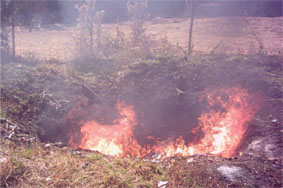Incineration
Incinerators convert combustible materials into ashes or residues. Gases are ventilated through the chimney stack into the outer air. If the incinerator is properly designed, maintained and operated, it serves the purpose of destroying infectious microorganisms in the waste.
In the context of waste management, incineration means more than just burning. It means controlled and managed burning, usually at high temperature. A waste incinerator needs to reach very high temperatures in order to completely destroy needles and syringes. This type of high temperature incinerator is unlikely to be available to you but other options for burning can be used at rural health facility level. With the help of others in your community, you may be able to build a low temperature incinerator, also known as a protected hearth.

If a brick-built incinerator is not available, you may be able to burn the waste in a converted metal drum or barrel. To do this, you will need a metal drum with both ends removed to make a cylindrical container. You will also need four bricks and two rigid metal screens that are large enough to cover the open ends of the drum. You will need to place the drum in a fenced area away from the health facility buildings. Place the bricks on the ground, with spaces between them and a metal screen or grate on top. Place the open base of the drum on the metal screen and put another screen on top. The metal screens are to allow air to flow around the burning waste so the fire gets hotter, and to reduce the amount of ashes flying out of the top. Put the safety box or other waste with some paper, dry leaves, or small sticks into the drum and sprinkle them with a small amount of kerosene (if available). Put paper under the drum, between the bricks, and set light to it so the flames rise through the metal screen.
If there are no incinerators, then open pit burning is also possible, and frequently used in rural health facilities. The pit must be protected with a fence to prevent people or animals from gaining access to it. It is advisable to watch the fire until everything is burned to be sure that no waste is blown around by the wind or left unburned. The ash or residue must be buried for final disposal.
